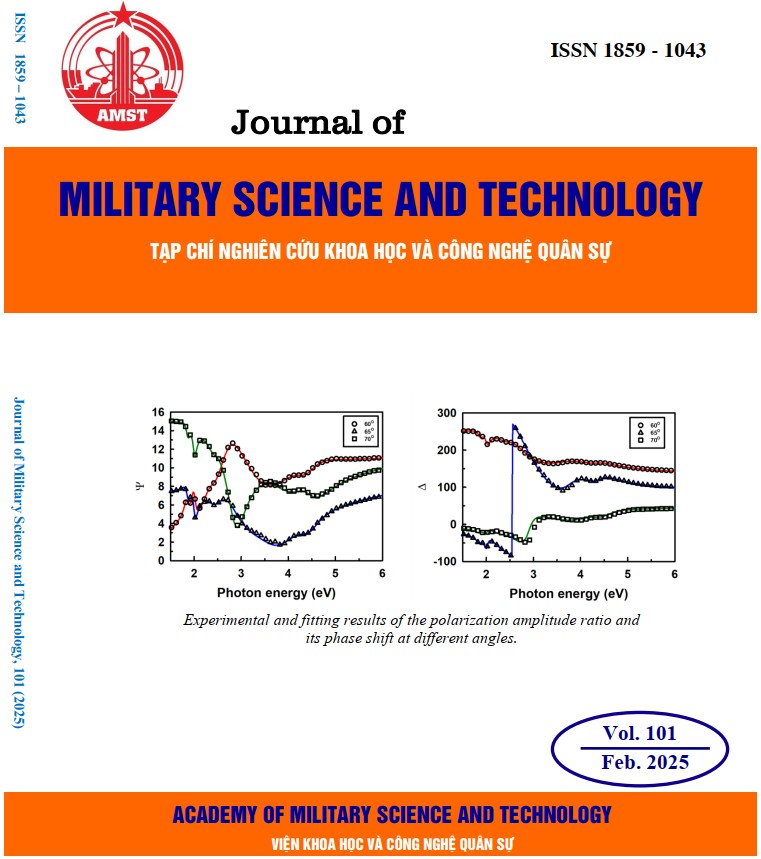Optical characterization of 2D heterostructure MoS2/WS2 using spectroscopic ellipsometry
487 viewsDOI:
https://doi.org/10.54939/1859-1043.j.mst.101.2025.117-123Keywords:
Heterostructure MoS2/WS2; Spectroscopic ellipsometry; Tauc-Lorentz model; Optical properties.Abstract
TMDC materials like MoS2 and WS2 are well known for their unique monolayer properties, ideal for optoelectronic applications. Stacking these monolayers enhances the properties beneficial for light detection and harvesting devices. This study investigates the dielectric function and critical point (CP) energies of heterostructure MoS2/WS2 using spectroscopic ellipsometry (SE) within the spectral range of 1.5 to 6.0 eV at different angles. The SE method, employing the Tauc-Lorentz model for detailed analysis, confirms the formation of high-quality TMDC heterostructure and provides precise values for intrinsic properties. These results are crucial for optimizing TMDC-based optoelectronic devices for military and commercial applications.
References
[1]. S. Manzeli, et al., “2D transition metal dichalcogenides”, Nature Reviews Materials, Vol. 2, No. 8, pp. 1-15, (2017). DOI: https://doi.org/10.1038/natrevmats.2017.33
[2]. A. Chaves, et al., “Bandgap engineering of two-dimensional semiconductor materials”, npj 2D Materials and Applications, Vol. 4, No. 1, pp. 29, (2020). DOI: https://doi.org/10.1038/s41699-020-00162-4
[3]. D. Monga, et al., “Advances in transition metal dichalcogenide-based two-dimensional nanomaterials”, Materials Today Chemistry, Vol. 19, No. pp. 100399, (2021). DOI: https://doi.org/10.1016/j.mtchem.2020.100399
[4]. M. Wu, et al., “Synthesis of two‐dimensional transition metal dichalcogenides for electronics and optoelectronics”, InfoMat, Vol. 3, No. 4, pp. 362-396, (2021). DOI: https://doi.org/10.1002/inf2.12161
[5]. X. Wu, et al., “Recent advances on transition metal dichalcogenides for electrochemical energy conversion”, Advanced Materials, Vol. 33, No. 38, pp. 2008376, (2021). DOI: https://doi.org/10.1002/adma.202008376
[6]. X. Wu, et al., “Recent Advances on tuning the interlayer coupling and properties in van Der Waals heterostructures”, Small, Vol. 18, No. 15, pp. 2105877, (2022). DOI: https://doi.org/10.1002/smll.202105877
[7]. M.S. Stark, et al., “Intercalation of layered materials from bulk to 2D”, Advanced Materials, Vol. 31, No. 27, pp. 1808213, (2019). DOI: https://doi.org/10.1002/adma.201808213
[8]. F. He, et al., “Moiré patterns in 2D materials: a review”, ACS nano, Vol. 15, No. 4, pp. 5944-5958, (2021). DOI: https://doi.org/10.1021/acsnano.0c10435
[9]. X. Guan, et al., “Recent progress in short‐to long‐wave infrared photodetection using 2D materials and heterostructures”, Advanced Optical Materials, Vol. 9, No. 4, pp. 2001708, (2021). DOI: https://doi.org/10.1002/adom.202001708
[10]. A. Elbanna, et al., “2D material infrared photonics and plasmonics”, ACS nano, Vol. 17, No. 5, pp. 4134-4179, (2023). DOI: https://doi.org/10.1021/acsnano.2c10705
[11]. H. Li, et al., “Recent progress and strategies in photodetectors based on 2D inorganic/organic heterostructures”, 2D Materials, Vol. 8, No. 1, pp. 012001, (2020). DOI: https://doi.org/10.1088/2053-1583/abbf04
[12]. Z. Yan, et al., “Emerging two‐dimensional tellurene and tellurides for broadband photodetectors”, Small, Vol. 18, No. 20, pp. 2200016, (2022). DOI: https://doi.org/10.1002/smll.202200016
[13]. X. Chen, C. Liu, and S. Mao, “Environmental analysis with 2D transition-metal dichalcogenide-based field-effect transistors”, Nano-micro letters, Vol. 12, No. pp. 1-24, (2020). DOI: https://doi.org/10.1007/s40820-020-00438-w
[14]. D. Tyagi, et al., “Recent advances in two-dimensional-material-based sensing technology toward health and environmental monitoring applications”, Nanoscale, Vol. 12, No. 6, pp. 3535-3559, (2020). DOI: https://doi.org/10.1039/C9NR10178K
[15]. M.S. Rahman and L.F. Abdulrazak, “Utilization of a phosphorene-graphene/TMDC heterostructure in a surface plasmon resonance-based fiber optic biosensor”, Photonics and Nanostructures-Fundamentals and Applications, Vol. 35, No. pp. 100711, (2019). DOI: https://doi.org/10.1016/j.photonics.2019.100711
[16]. K. Setayeshmehr, M. Hashemi, and N. Ansari, “Photoconversion efficiency in atomically thin TMDC-based heterostructures”, Opt. Express, Vol. 29, No. 21, pp. 32910-32921, (2021). DOI: https://doi.org/10.1364/OE.438386
[17]. Z. Hu, et al., “Interfacial charge and energy transfer in van der Waals heterojunctions”, InfoMat, Vol. 4, No. 3, pp. e12290, (2022). DOI: https://doi.org/10.1002/inf2.12290
[18]. I. Shahbaz, et al., “Advancements in 2D transition metal dichalcogenides (TMDs) inks for printed optoelectronics: A comprehensive review”, Materials Today, No., (2024). DOI: https://doi.org/10.1016/j.mattod.2024.06.008
[19]. C. Cong, et al., “Optical properties of 2D semiconductor WS2”, Advanced Optical Materials, Vol. 6, No. 1, pp. 1700767, (2018). DOI: https://doi.org/10.1002/adom.201700767
[20]. Y. Chen and M. Sun, “Two-dimensional WS 2/MoS 2 heterostructures: Properties and applications”, Nanoscale, Vol. 13, No. 11, pp. 5594-5619, (2021). DOI: https://doi.org/10.1039/D1NR00455G
[21]. R. Dutta, et al., “Optical Enhancement of Indirect Bandgap 2D Transition Metal Dichalcogenides for Multi‐Functional Optoelectronic Sensors”, Advanced Materials, Vol. 35, No. 46, pp. 2303272, (2023). DOI: https://doi.org/10.1002/adma.202303272
[22]. M. Wang, et al., “Manufacturing strategies for wafer-scale two-dimensional transition metal dichalcogenide heterolayers”, J. Mater. Res., Vol. 35, No. 11, pp. 1350-1368, (2020). DOI: https://doi.org/10.1557/jmr.2020.27
[23]. Y. Li, et al., “Measurement of the optical dielectric function of monolayer transition-metal dichalcogenides: MoS 2, Mo S e 2, WS 2, and WS e 2”, Physical Review B, Vol. 90, No. 20, pp. 205422, (2014).
[24]. X. Zhu, et al., “Effects of dielectric screening on the excitonic and critical points properties of WS 2/MoS 2 heterostructures”, Nanoscale, Vol. 12, No. 46, pp. 23732-23739, (2020). DOI: https://doi.org/10.1039/D0NR04591H
[25]. H.T. Nguyen, et al., “Temperature dependence of optical properties of monolayer WS2 by spectroscopic ellipsometry”, Applied Surface Science, Vol. 511, No. pp. 145503, (2020). DOI: https://doi.org/10.1016/j.apsusc.2020.145503
[26]. J. Humlíček, “Polarized light and ellipsometry”, in Handbook of ellipsometry. Springer. p. 3-91, (2005). DOI: https://doi.org/10.1016/B978-081551499-2.50003-4
[27]. R. Azzam, “Polarization, thin-film optics, ellipsometry, and polarimetry: Retrospective”, Journal of Vacuum Science & Technology B, Vol. 37, No. 6, (2019). DOI: https://doi.org/10.1116/1.5122802
[28]. B. Von Blanckenhagen, D. Tonova, J. Ullmann, “Application of the Tauc-Lorentz formulation to the interband absorption of optical coating materials”, Appl. Opt., Vol. 41, No. 16, pp. 3137-3141, (2002). DOI: https://doi.org/10.1364/AO.41.003137
[29]. L.V. Rodríguez-de Marcos, J.I. Larruquert, “Analytic optical-constant model derived from Tauc-Lorentz and Urbach tail”, Opt. Express, Vol. 24, No. 25, pp. 28561-28572, (2016). DOI: https://doi.org/10.1364/OE.24.028561
[30]. D.V. Likhachev, N. Malkova, and L. Poslavsky, “Modified Tauc–Lorentz dispersion model leading to a more accurate representation of absorption features below the bandgap”, Thin Solid Films, Vol. 589, No. pp. 844-851, (2015). DOI: https://doi.org/10.1016/j.tsf.2015.07.035
[31]. X. Ling, et al., “Parallel stitching of two-dimensional materials”, arXiv preprint arXiv:1512.04492, No. (2015).
[32]. J. Zhang, et al., “Observation of strong interlayer coupling in MoS2/WS2 heterostructures”, Advanced Materials, Vol. 28, No. 10, pp. 1950-1956, (2016). DOI: https://doi.org/10.1002/adma.201504631
[33]. S. Tongay, et al., “Tuning interlayer coupling in large-area heterostructures with CVD-grown MoS2 and WS2 monolayers”, Nano letters, Vol. 14, No. 6, pp. 3185-3190, (2014). DOI: https://doi.org/10.1021/nl500515q







